Category Archive for Art + Design
Takashi Murakami: Japanese kawaii exhibit at Vancouver Art Gallery! Hello Kitty Taipei airport lounge & gift shop.
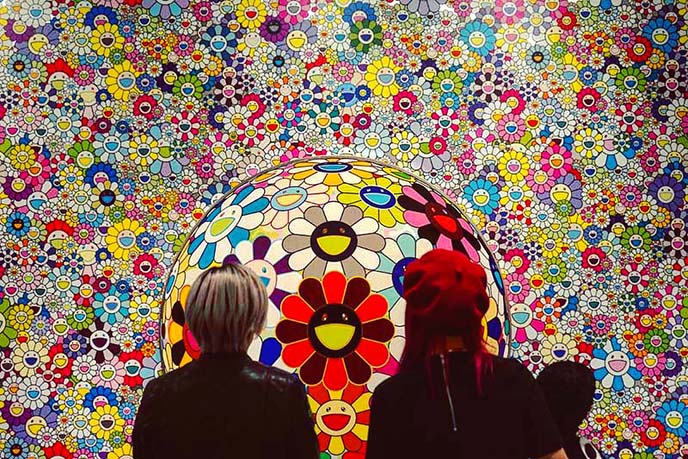
When one of your favorite Japanese artists is in town… It’s time to get trippy!
If you love manga, anime and “kawaii” Japanese pop culture, then head down the rabbit hole to Takashi Murakami’s exhibit at Vancouver Art Gallery.
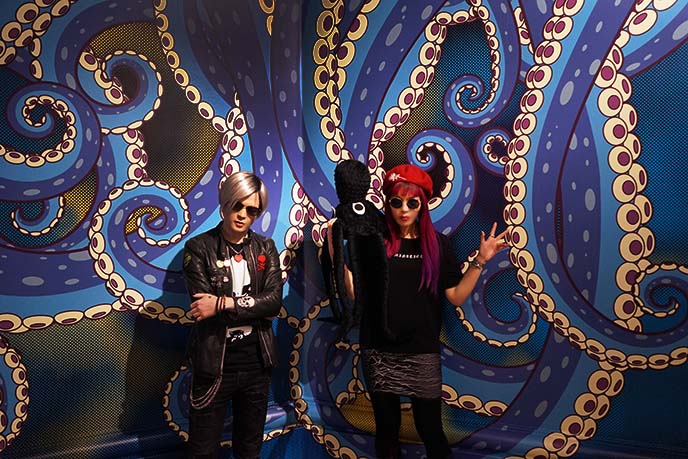
For the first time, Murakami’s major works have come to Canada. Over 50 pieces spanning three decades are currently on display at VAG (from Feb 2 to May 6, 2018).
The retrospective is titled “The Octopus Eats Its Own Leg,” so get ready to dive into a world of tentacles.

Read on to the end of this story, where I’ll also share photos of the Hello Kitty airport lounge in Taipei (since we’re on the topic of Japanese pop-cute). It’s definitely the world’s weirdest airline lounge, featuring Sanrio characters!
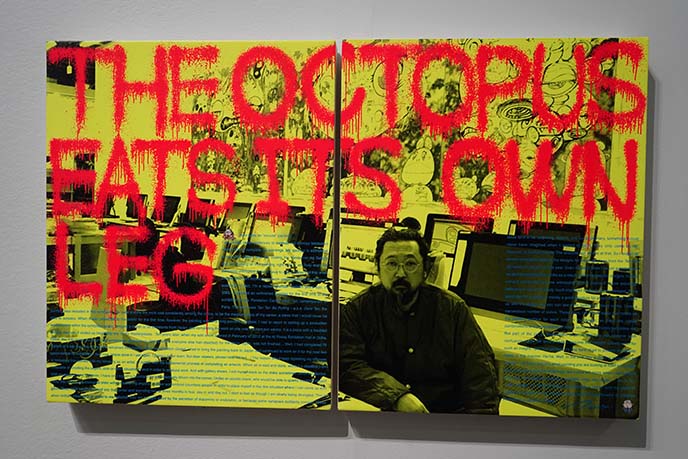
Murakami Takashi (村上 隆) is one of Japan’s most intriguing contemporary artists. You might recognize his smiling flowers and cartoon bears, which were on the cover of a Kanye West album and Louis Vuitton purses.
However, as I found out from this exhibit, Murakami’s artistic tentacles reach far deeper than pop commentary on consumer culture. The exhibition’s title, “The Octopus Eats Its Own Leg,” refers to a Japanese parable where the creature survives by sacrificing parts of himself. In this way, “Takashipom” consumes his native history and spirituality, transforming them into colorful new visions.

The Vancouver Art Gallery went all-out to welcome Murakami. Each window is plastered with happy flower decals, and the rotunda looks like it’s been attacked by a pink and blue cephalopod, Godzilla-style. The artist himself came here for the opening, dressed in a tentacles-hat for the occasion.
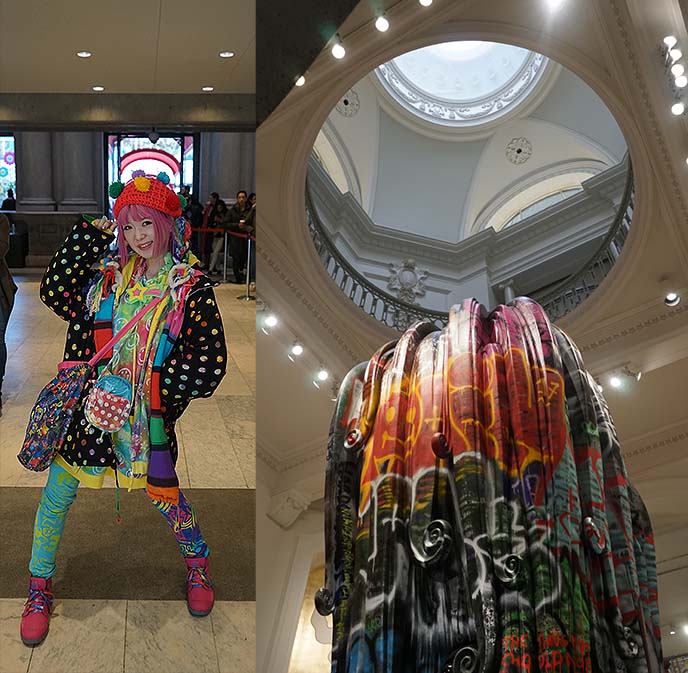
The Murakami exhibition is already an immense success, drawing in queues of visitors. Instead of spending time in line, I recommend that you purchase a ticket in advance from the Vancouver Art Gallery website (it lets you choose the specific date of your visit.) You may also want to aim for a weekday visit, since the space was packed over the weekend.
The Japanese artist is known for his eccentric outfits. I was pleased to see that a few visitors dressed up for the occasion; I loved this girl’s Harajuku decora candy style.

During the grey winter months, it’s a joy to wander among giant neon paintings with friends.
Murakami’s best-known works are influenced by Japanese “kawaii’ (big-eyed, round cuteness), with nods to anime, manga and otaku culture. However, these critters always have a deadly or bizarre twist
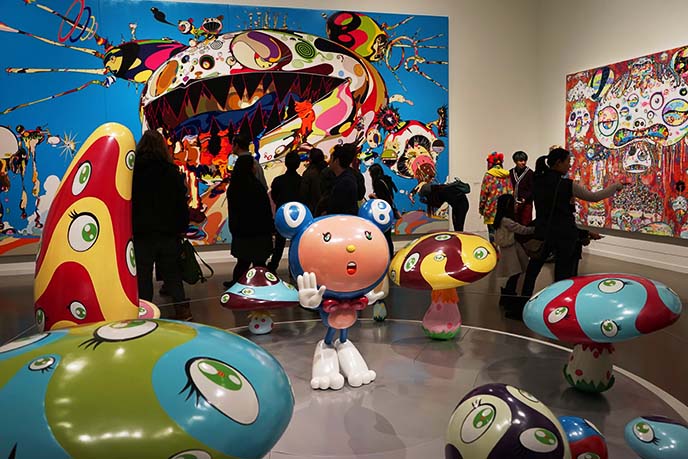
The exhibition spans several huge rooms, and includes wall-sized works and ceiling-high sculptures. Many feature Mr. Dob, his cute character who is a bit like Hello Kitty meets Mickey Mouse.
In his 3D work “DOB in The Strange Forest,” Murakami surrounds the innocent mouse-bear with seeing-eyed mushrooms. In the back, he’s become an unhinged monster spewing vomit (the painting is called “Tan Tan Bo Puking.”)
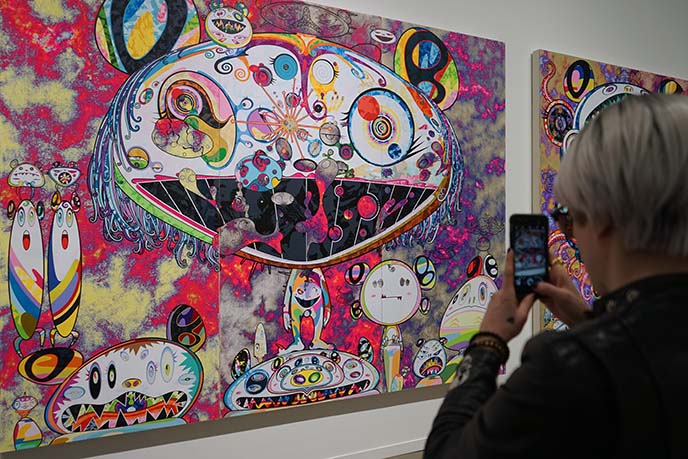
The mutant Mr. Dob reflects on how icons can run amok, hiding sharp fang beneath inviting surfaces. Despite this commentary on consumerism, Mr. Dob has (ironically? purposefully?) become a popular design on Louis Vuitton bags and other branded designer goods.
(Click the images below to see Murakami’s art x commerce collaborations):
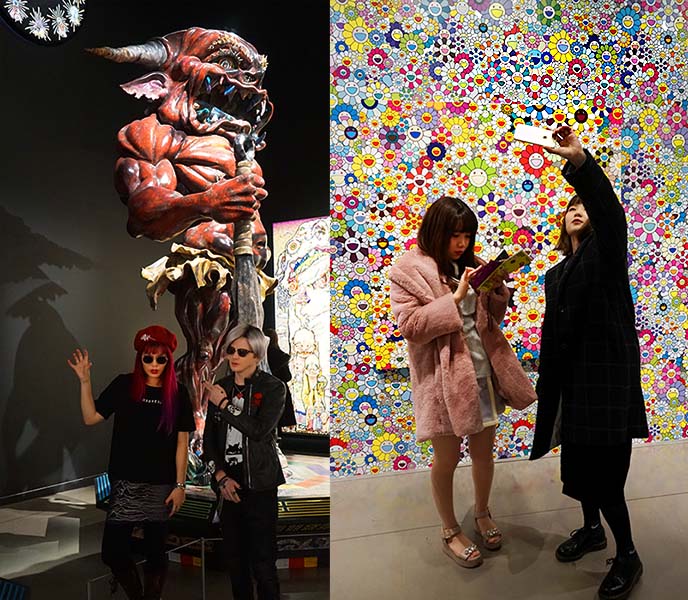
Anyone can take photos inside the exhibition, which makes it highly Instagrammable. One of the most popular selfie-spots is in front of this happy floral wall. Murakami once described these flowers as making him “feel almost physically sick, and at the same time I found them very cute.”

We’re mesmerized by “Flower Ball.” As Ben mused, “Where does art end, and wallpaper begin?”

Murakami is best known for his “Superflat” high-meets-low, 2D pop imagery. However, he explores many other facets of Japanese culture in other works, often with a darker vibe.

One of the most powerful rooms held towering red and blue demon totems (Embodiment of “A” and Embodiment of “Um”). These statues imagine a present-day belief system, built on ancient myths and folklore.

Murakami was devastated by the 2011 Japan earthquake and tsunami. The tragedy inspired a new direction in his art: he drew upon Japan’s cultural heritage to create spiritual narratives.
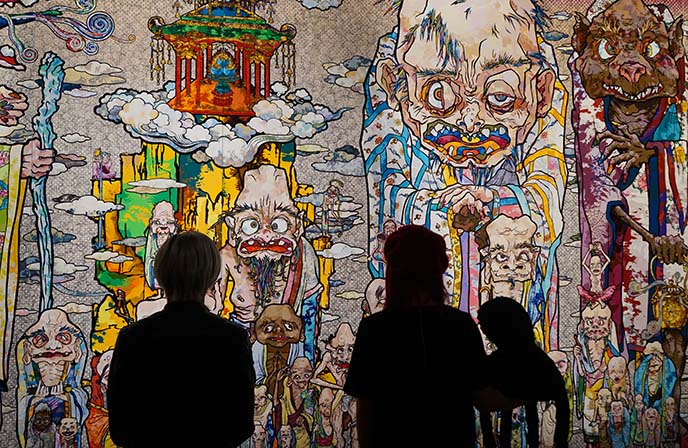
One of these masterpieces from this era is on display: a 10-panel painting called “The 100 Arhats.” It was painstakingly made by layering hundreds of silk screens, and depicts Buddhist monks who roamed Japan and helped enlighten people.

Many of Murakami’s works are inspired by “Nihonga,” the late 19th century fusion of Western and Japanese artistic techniques. In the above work, “Of Chinese Lions, Peonies, Skulls and Fountains”, he illustrates the legend of the lion who guards Buddhist temples. The cute baby cub and rainbow stream of skulls made it one of my favorites.
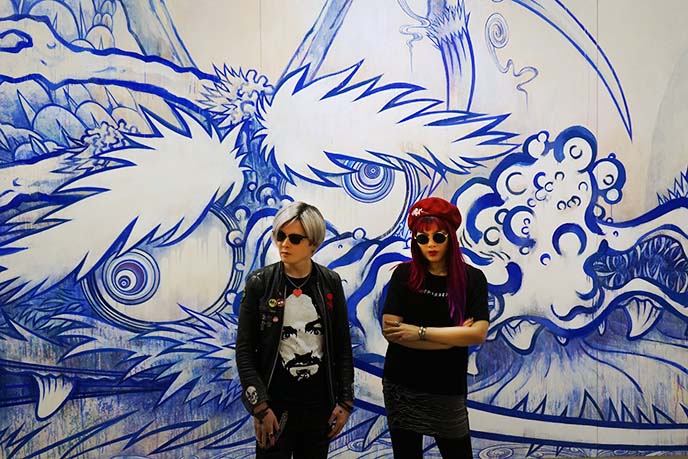
Murakami’s works are big, in terms of both size and concept. This is “Dragon in Clouds – Indigo Blue”, a re-imagining of a 1763 Japanese fantasy painting by Soga Shohaku.

Takashi Murakami is often compared to Andy Warhol. The Japanese artist is better received outside of his homeland, where some deride him for being too commercial/marketing oriented. Personally, I think these detractors are only skimming the surface; both artists made provocative works that went far deeper than soup cans and smiley flowers.
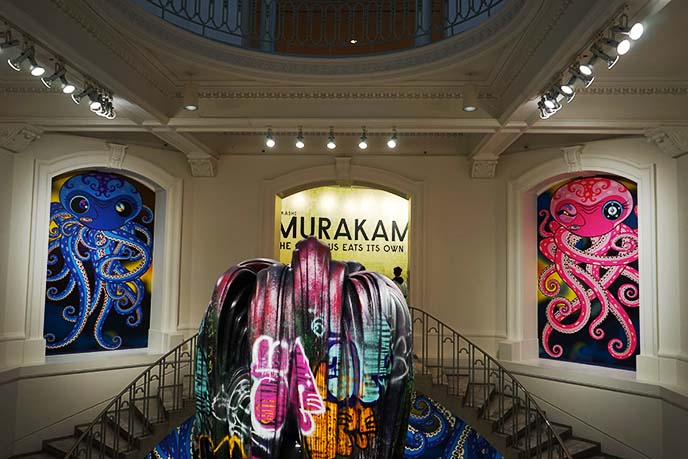
Intrigued? I encourage you to come out to Vancouver Art Gallery to see Murakami’s works in person. There’s no other way to get a full sense of his scale and impact.
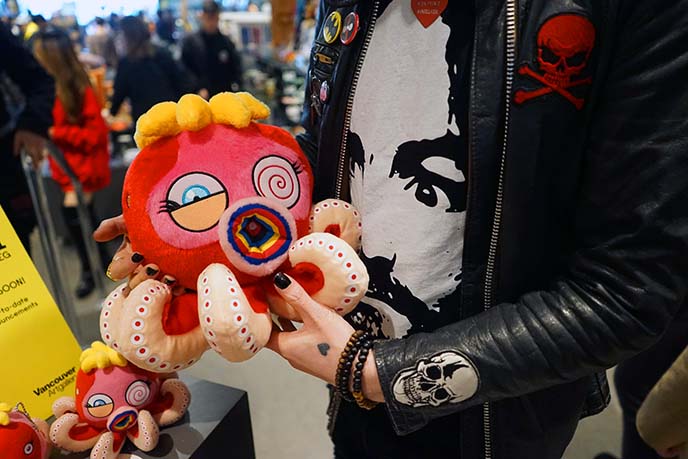
Exit through the gift store... There’s a selection of pins, toys, prints and more. This bizarro octopus plush caught our eye. Looks like something that Charles Manson might embrace.
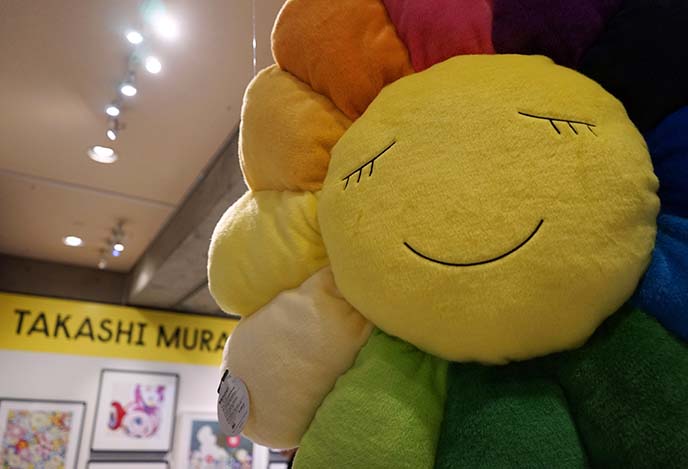
Have you heard of Takashi Murakami? Are you also a fan of his work? (You can browse his fashion designs below:)

A final close-up of Murakami’s flowers (note the tiny faces), and my outfit of the day. My red 90s beret and Domination top are by Mary Wyatt London. My round minimalist sunglasses are Edwardson Eyewear.

I’m also loving my new Bulgari Serpenti metallic leather bracelet, which matches my snake plant! I only wear jewelry with edge; the ring is Alex Streeter. (More Blvgari bracelets below):

Since we’re on the subject of “kawaii” culture… I thought I’d end with photos I took during a stopover, at Taipei’s Taoyuan Airport. If you go to Terminal 2, gate C3… you’ll discover a Hello Kitty airport lounge!
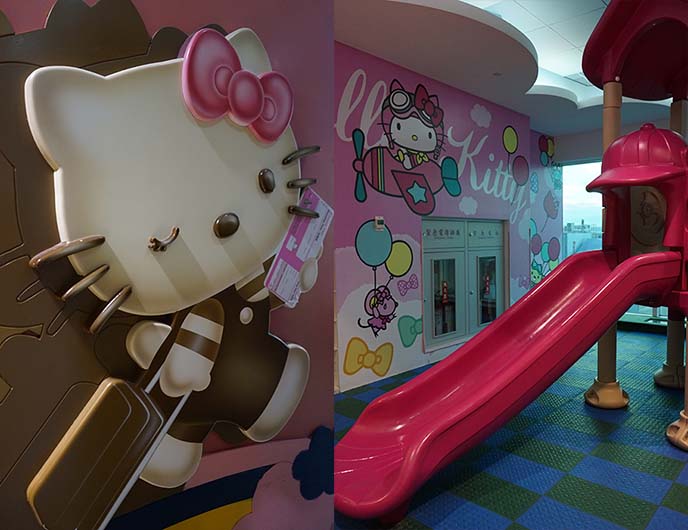
Although Hello Kitty is from Japan, the mouth-less cat is popular all over Asia. Taiwan loves her so much that they have an airport lounge in her name. The large waiting area has plenty of seats, a kid’s play area, and a nursing station featuring images of baby Kitty and Daniel.
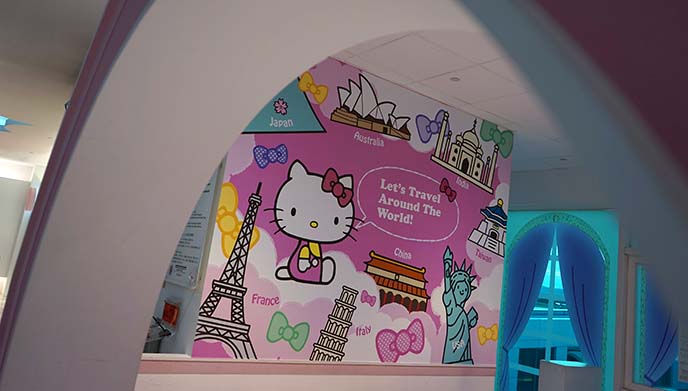
Taiwan’s Eva Air even launched a Hello Kitty jet, which mainly flies routes to Japan. Everything about the flight is in her likeness: the tickets, staff outfits, food, and art on the side of the airplane. (The Hello Kitty plane was so popular that EVA Airlines now also has Pokemon and Gudetama themed flights.)

In Taipei’s airport lounge, Hello Kitty is depicted as a world traveller. We see her wearing pilot goggles, and toting a suitcase behind her with a wink. The murals show the cat flying on her pink airplane to Sydney, India, New York, Rome and Paris.

These pictures are pretty accurate if you think of it… Since Sanrio launched her in 1974, Hello Kitty has taken over the world. I see merchandise with her face on it everywhere I travel.

I filmed an Instagram video here that shows you more of the pink, ridiculous terminal. Is this Hello Kitty heaven… or hell? That’s all up to you.
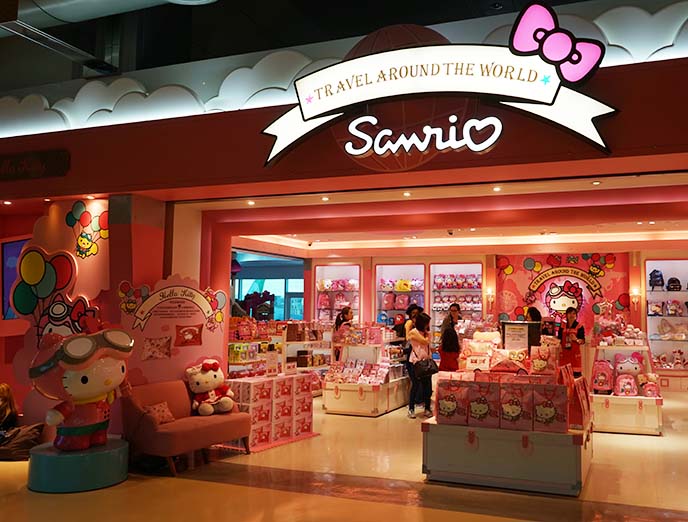
Right next door is the ultimate gift store, aptly named Hello Kitty Dream World. Taiwan Taoyuan airport has a few Sanrio shops, and they’re open from early morning to late evening.

“I like to stop at the duty free shop!” Especially when it’s filled with rare Hello Kitty and Sanrio character goods. I was tempted to get stationery, stuffed toys, jewelry, backpacks, kitchen items…

Hello Kitty isn’t just for children. Sanrio has released multiple designer fashion and jewelry collaborations. I’m eyeing this Hello Kitty sequin dress, cashmere sweater and more below…

Over the years, Sanrio has added more adorable animals to the family. Above is Bad Badtz Maru, Pompompurin, Cinnamon Roll and My Melody.

Some of the character items are on the weird side. I need a Hello Kitty robot cleaner in my life…

If you’re planning a trip to Taipei or doing a layover, look out for the Hello Kitty lounge in Taoyuan Airport (Terminal 2, section C3).

I grew up with Hello Kitty, so I’ll always have a soft spot for her. How about you?
And what do you think of Takashi Murakami’s mind-bending exhibit?
SHARE & COMMENT
HR Giger Museum & Bar in Gruyeres, Switzerland: Goth sci-fi travel guide! Alien movie art, Necronomicon paintings.

Star Beast achievement unlocked. I made it to the HR Giger Museum and Bar in Switzerland!
While in Europe last fall, I made a weekend detour to Gruyères to see the museum dedicated to one of my favorite artists: H.R. Giger. I’m sure you’ll recognize his surrealist concept art for Alien, Species, Poltergeist 2, the never-made Dune, and other sci-fi horror films.
If you share my fascination with Giger’s biomechanical visions, then this travel story will make you want to drop everything and fly to Switzerland. Read on for a tour of the Giger museum and bar, including exclusive photos of his rare artwork inside the chateau!
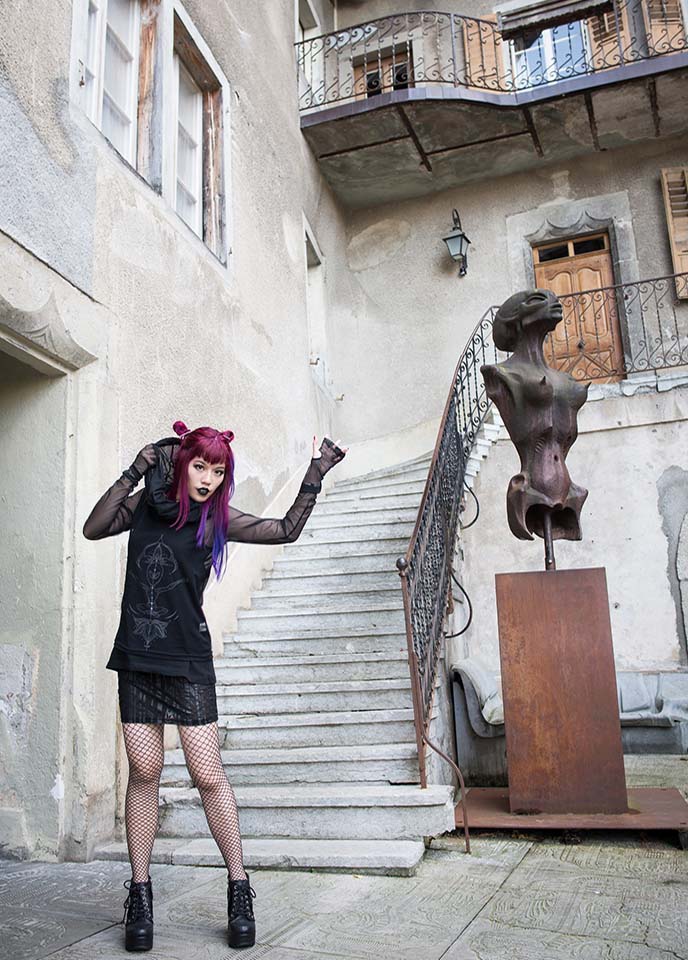
This unassuming Swiss castle houses a motherload of dark biomechanical creatures. Open since 1998, the museum contains some of Giger’s most famous works, as well as rare early pieces and erotic art. We’re grateful to La Gruyère Tourism for the warm welcome and help with journalist access to the museum.
Outfit Details: It seemed appropriate to dress cybergoth for the occasion. My outfit is 100% Cyberdog: I layered their semi-sheer bodycon dress, alien “yogalien” tank top, and black mesh hooded long sleeved top. Cyberdog’s futuristic sci-fi fashion is sold online, as well as in their giant Camden Market store.

Giger museum access / How to get here: Photographer Joey Wong and I came from London, and it only took us 1.5 hours to fly to Geneva. We then traveled from Geneva to Gruyeres by train, using the First Class Swiss Travel Pass from Switzerland Tourism. This gave us unfettered access to the country’s trains, buses and boats; it turned out to be a beautiful journey through the countryside, which I’ll show you in an upcoming post.
Musee HR Giger address: Château St. Germain, Rue du Château 2, 1663 Greyerz, canton Fribourg, Switzerland. Gruyeres is a small town with only about 2000 inhabitants, so the museum is easy to find.

The cosmic horror begins outside the museum, which is flanked by several ominous sculptures. The front entrance has a metal adaptation of his painting Gebärmaschine (“Birth Machine”) from 1967. Giger created this work as a commentary on population growth.
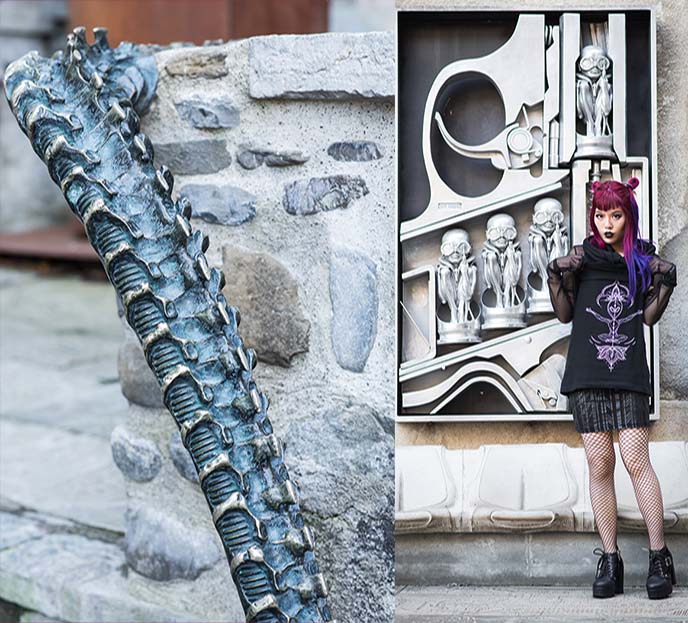
The “birth machine” depicts goggled babies holding guns, sitting on bullets inside a larger pistol. Giger meant to convey that the babies would be shot out, but in fact, only their heads would be (the decapitated bodies would remain in the bullet casing). Somehow, that seems more fitting for this master of sci-fi terror!
On the left, the front staircase has the coolest handrail ever — a twisting alien spinal cord.

Starting with the exterior, the museum evokes a feeling of dark, otherworldly mystery that is quintessentially HR Giger.
(My silver futuristic hair clip is Hair DesignAccess by Sylvain Le Hen.)
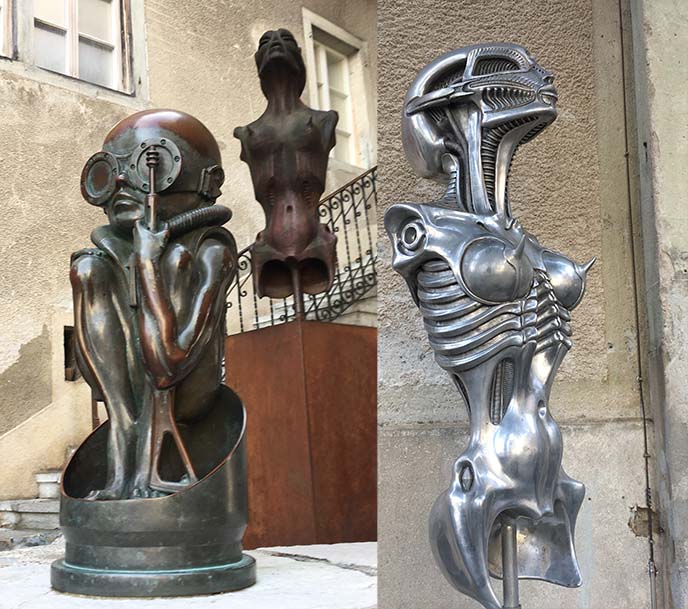
These extraterrestrial figures convey Giger’s signature aesthetic, which he called “biomechanical.” The term describes his surrealistic approach, which fuses organic elements with the mechanical. Part human and part machine — melded together in a beautiful yet uneasy alien hybrid.

Giger’s forms tend to resemble human bodies, but with a deadly twist. It’s surprisingly powerful to stumble across these cosmic creatures in Gruyeres, an otherwise quaint Swiss village.

Science fiction, double feature. My magenta to purple ombre hair is by Chad Evans in Vancouver, BC.
My black leather Gothic shoes with silver buckles are similar to these boots; click below for more options.

This elegant building is Château St. Germain, which dates back to 1663. HR Giger visited Gruyeres several times, and had an exhibition in the village. He fell in love with the scenic region, and bought this Swiss castle in 1997.

Since there was massive demand, Giger turned St Germain Castle into a museum with architect Roger Cottier. In 1998, the H.R. Giger Museum first opened its doors. It remains the permanent home to most of his key works, as well as the largest collection of his furniture, paintings and sculptures from over the years.
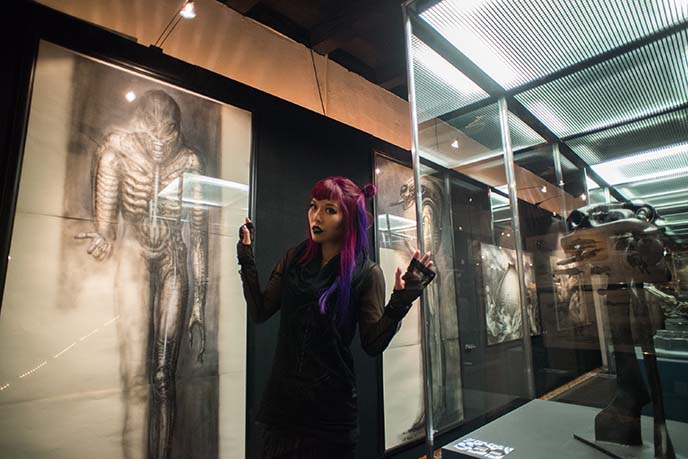
Visitors aren’t allowed to take photographs inside, but we were lucky to have media access. Read on for exclusive images of Giger’s works within the museum. But first…

… let’s head next door to the The Museum HR Giger Bar, which opened in Gruyeres in 2003!
My dress and collar are by Cyberdog. Silver radiator bracelet by Alex Streeter.

Step inside, and your jaw will drop — it’s like entering another universe! H.R. Giger designed the bar in a way that preserves the 400 year old Gothic architecture. He heightens the cavernous effect with dramatic skeletal arches that sweep over the ceiling.
Beneath these bony vaults are high-backed shell-like chairs. They were originally designed as a Harkonnen throne for the Dune film that never got made. (Keep reading to see another variant of the seats inside the museum).

I love how Giger turned the Medieval cathedral-like space into a bio-mechanical vision of the future. What an incredible feeling to curl up in one of these spinal chairs at the circular windows, and feel like you’ve been swallowed up by an intergalactic beast.

Tip: the Giger bar is extremely popular with tourists, so try to avoid lunch time and other peak hours. You may have to wait a while to get a seat at your preferred table. Above are photos from their website to give you a sense of the space and custom furniture; it was difficult to capture with all the visitors around.

The Gruyeres Giger bar is actually the fourth one ever built. Only one other location remains open: the H.R. Giger Bar in Chur, Switzerland (his place of birth), established 1992. The Chur interior has a similar backbone design, but it’s not as impressive as the bar beside the museum, which is the most famous one.

There was also a Giger Bar inside Peter Gatien’s legendary Limelight club in NYC, the site of many decadent Gothic and Club Kid parties. Sadly, when it closed in the 1990s, the bar did as well.
The earliest HR Giger bar was built in the late 1980s, in Japan! It was located in Shirokanedai, the Minato district of Tokyo. However, Giger grew dissatisfied with the Japanese builders and strict codes (for example, they couldn’t realize his idea of having private booths that doubled as individual elevators, moving up and down the bar). He ended his involvement with the Tokyo Giger bar, and it closed soon after.
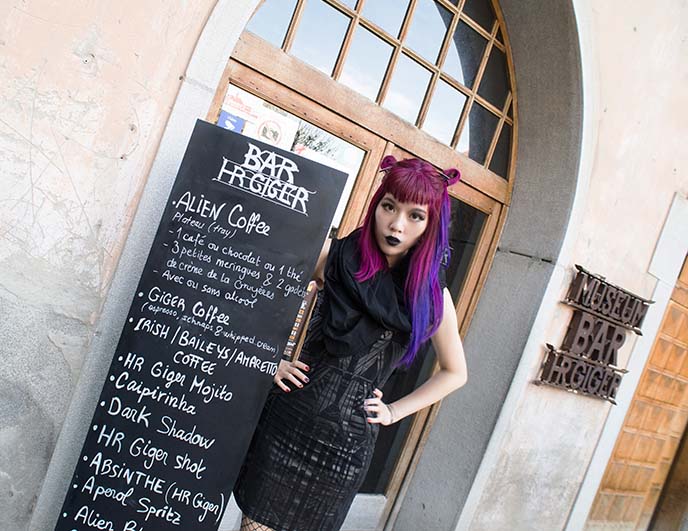
As you can see from the menu board, Bar HR Giger serves drinks and small snacks, including themed items. You can sip a Giger mojito, or dare to order the mysterious “Dark Shadow.” My Gothic preference is the HR Giger Absinthe, whcih I tried in Osaka, Japan.
The most visually interesting dish is the Alien Coffee, which comes on a wooden tray with little meringues, and honey herb liqueur.

Ready to head inside Chateau St. Germain, and take a tour of the Giger Museum? Let’s do it.
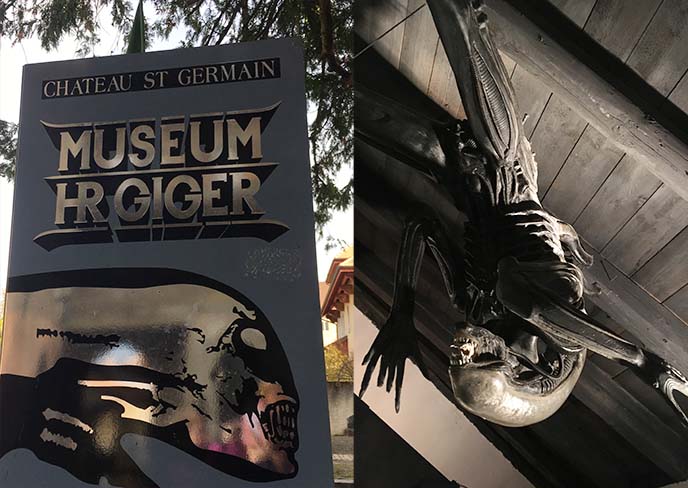
Just beware… xenomorphs lurk in the ceiling corners, waiting to attack you!
So, who is this twisted genius behind these creations? Hans-Rudolf (HR) Giger was born in 1940 in Chur, an Alpine city in the eastern part of Switzerland east. He moved to Zurich to study architecture and industrial design, and became known for illustrations and paintings that fuse humans and machine.
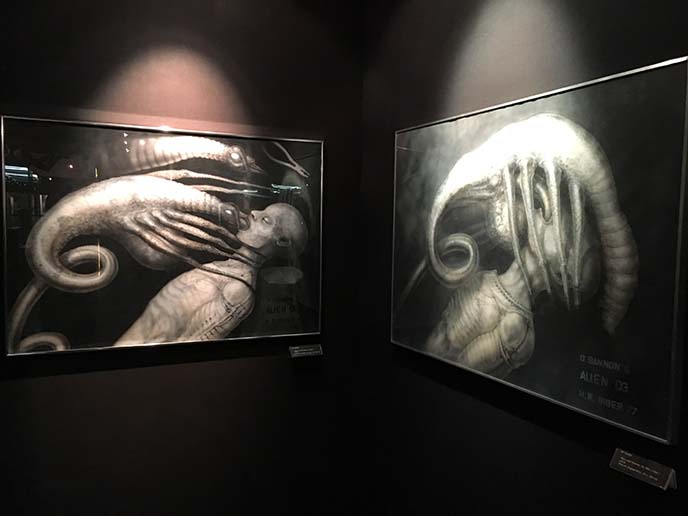
H.R. Giger is best known as the concept artist behind Ridley Scott’s “Alien” movie, which came out in 1979 and revolutionized science fiction horror films.
Above is his visualization of the “face hugger,” the portion of the Alien’s life cycle where it attaches to your face, and implants larvae through your mouth. When the babies mature, they burst through the human host’s chest in a bloody explosion — and continue to mature and stalk more prey.
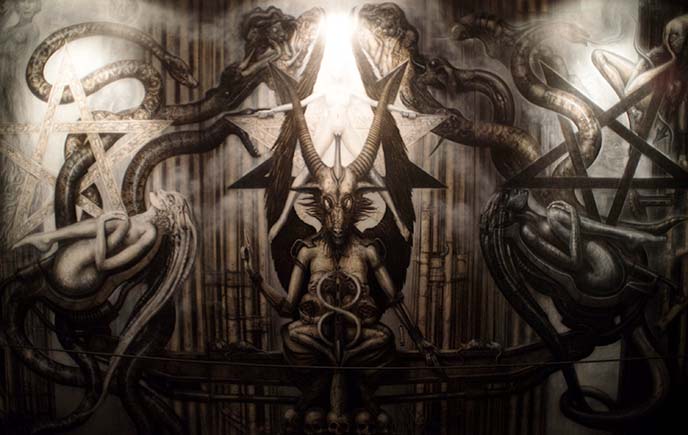
H. R. Giger was making terrifying imagery well before he joined the Alien movie. In 1977, he published a compendium of his art in a tome called the Necronomicon (much like HP Lovecraft’s collection of horror stories). During pre-production, director Ridley Scott got hold of the book, and immediately hired Giger to create the visuals for Alien.
The Gruyeres museum contains Spell IV, the gigantic work that graces the cover of Giger’s Necronomicon. It’s a painting of Baphomet the Sabbatic Goat, with Satanic pentagrams and serpents in his signature color palate.
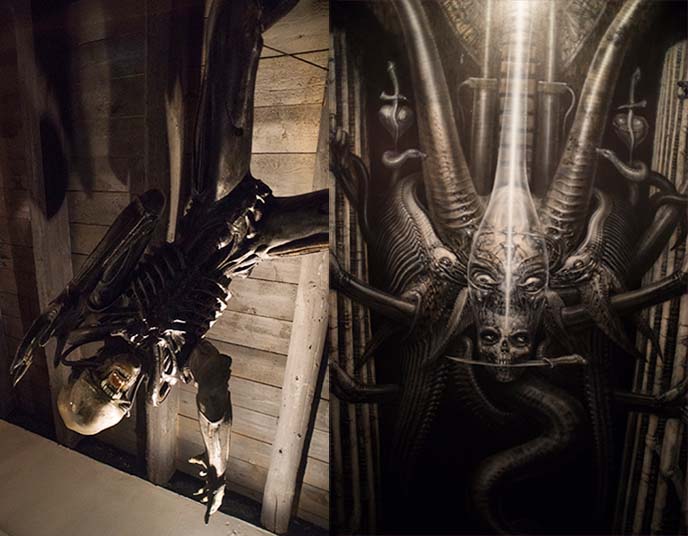
Alien’s impact earned the Swiss artist an Academy Award in 1980, for Best Achievement in Visual Effects. The Oscar statue is on display if you look closely, beneath one of the ancient staircases in the museum.
Ridley Scott liked Giger’s 1976 painting “Necronom IV,” which shows a being with an elongated skull, steel-like ribcage and pointed teeth. He asked Giger to create the alien based on the design…
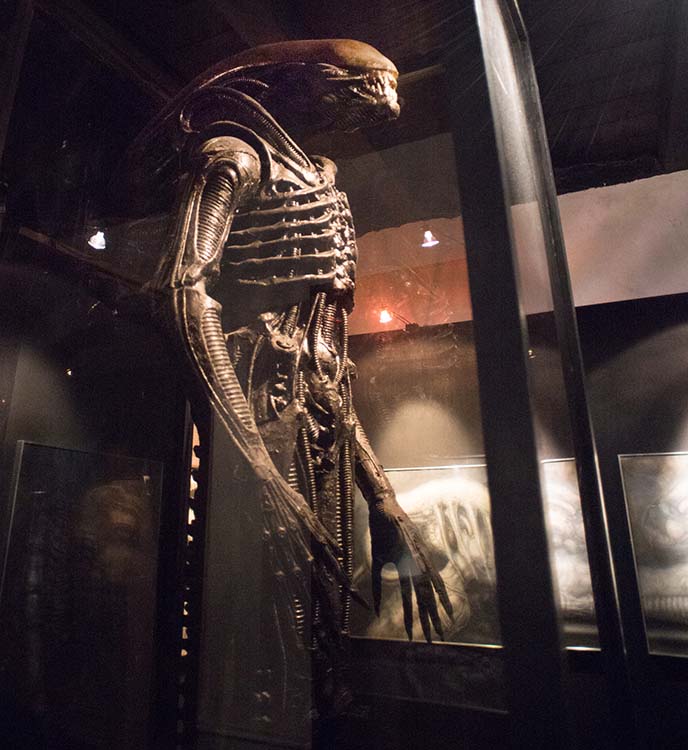
… and so, Giger gave birth to Xenomorph XX121! (The name refers to the alien species, and translates to “strange form” in Greek).
The museum has several xenomorphs of various sizes, ready to pounce on you. The largest one stands tall inside this glass display case (but if you recall the Prometheus birth scene, that wouldn’t even hold a newborn alien for long…)
If you’ve seen the Alien series, you’ll know to watch out for the segmented blade-tipped tails, burning acidic blood — and double-jawed set of teeth that extend out to pierce your flesh!
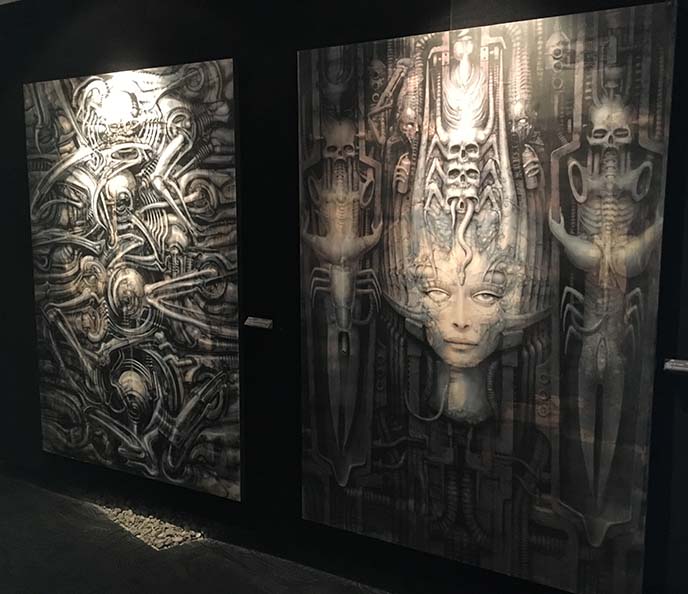
As you walk through the museum and take in the wall-to-ceiling art, you’ll realize that Giger has an entire pantheon of dark creatures. Above is Li II, inspired by his lover at the time, actress Li Tobler. She tore up the original Li painting because she thought it made her look ugly!
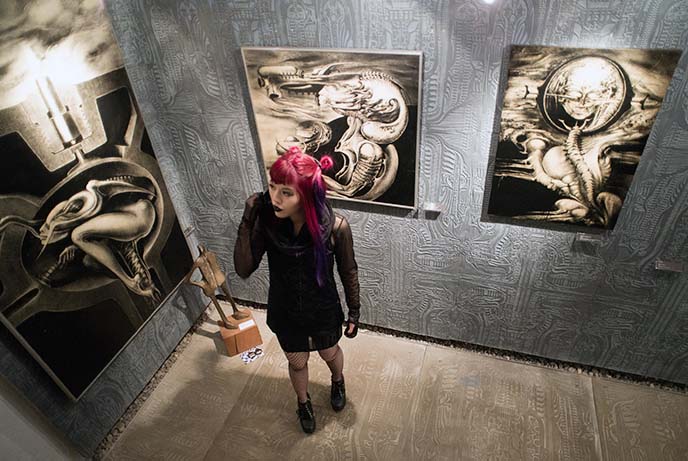
The HR Giger Museum is larger than you’d expect from the outside. Since it’s located in a 17th century castle, there are unexpected stairwells, rooms and hallways to navigate.
I enjoyed seeing Giger’s earliest works, from the 1960s: biomechanical otherworldly forms in acrylic and India ink on paper on wood. He truly was ahead of his time.
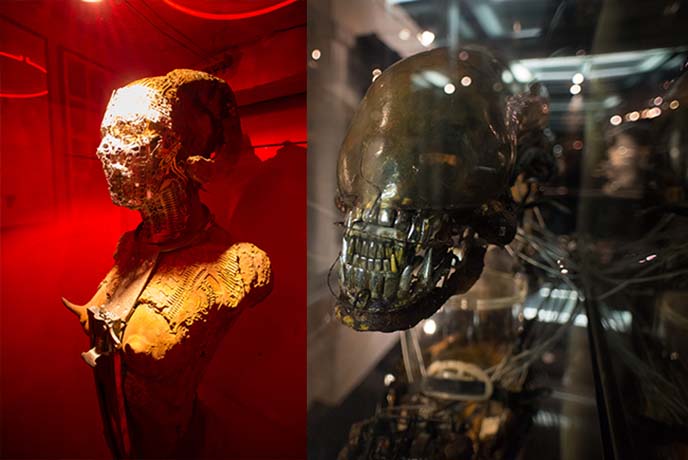
These busts made me think of the Alien movie tagline: “In space no one can hear you scream.”
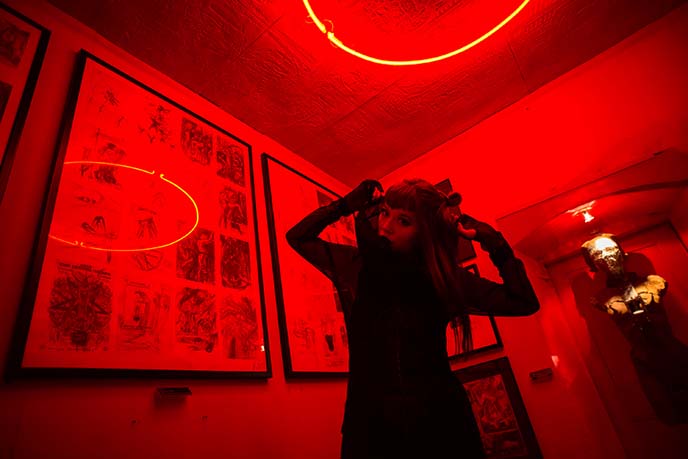
One section of the museum is adults only, and hidden behind a black curtain. Inside, the room is illuminated in red light and lined with his raciest works. Many of these sketches and sculptures have graphic imagery and Satanic overtones.
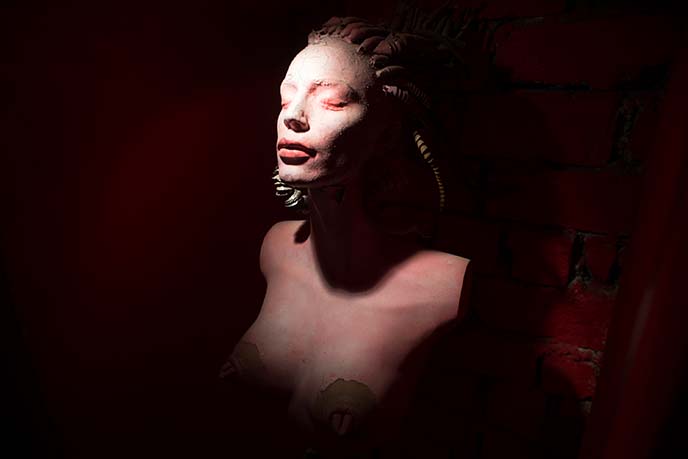
These cyborg fantasies were particularly shocking to conservatives of his time. Looking at his works today, it’s amazing to realize how much Giger has inspired everything from cyberpunk to tech design.
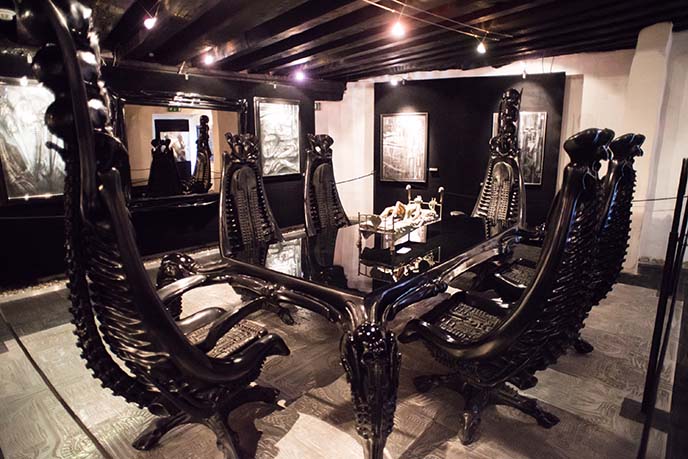
One of the largest rooms contains black Harkonnen Capo chairs around a table with biomechanical legs. This was one of Giger’s designs for Alejandro Jodorowsky, who was set to direct a movie adaptation of Dune, Frank Herbert’s influential sci-fi novel (and one of my personal favorites). Unfortunately, the 1976 film never got past pre-production and eventually was passed on to director David Lynch, who did not use Giger’s conceptualizations.
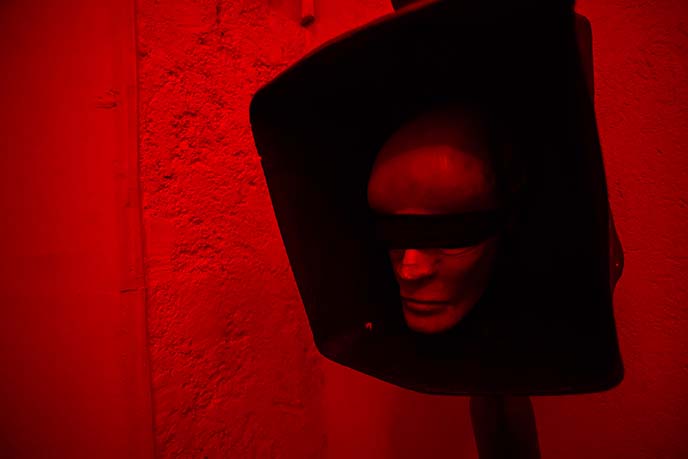
Where did Giger’s demonic imagination come from? Partly from night terrors. The Swiss artist kept a sketchbook next to his bed, and would jot down these visions.
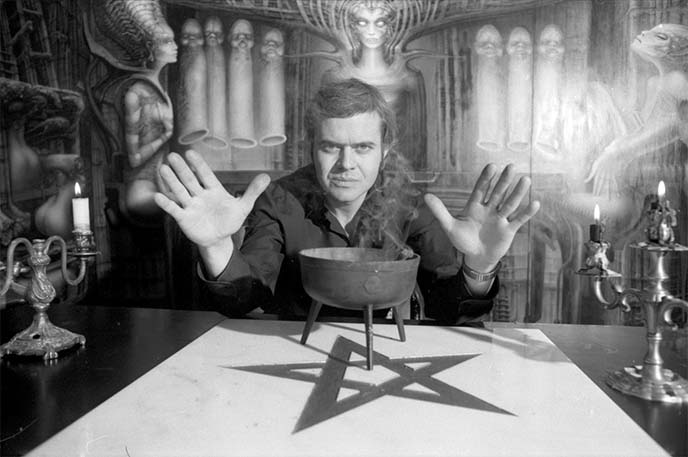
Giger (pictured above) was known to incorporate Satanic and occult imagery into his work. He even released a Baphomet Tarot card deck.
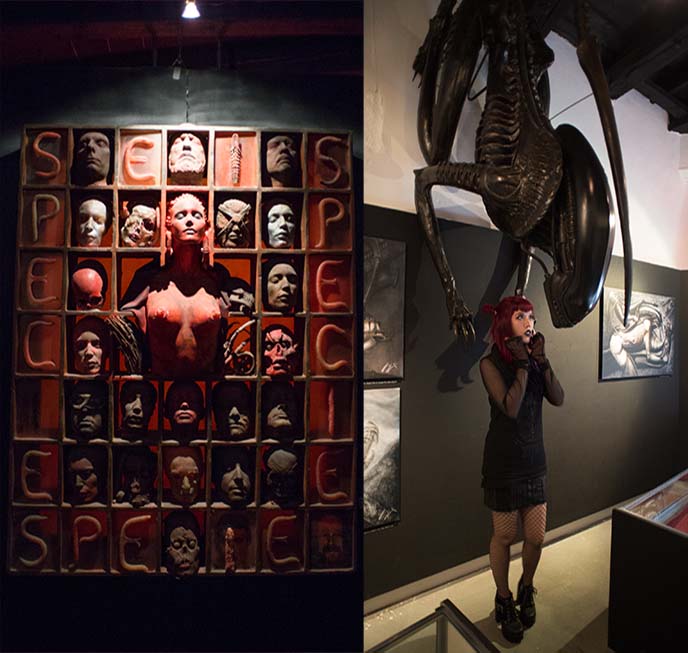
I channeled Ellen Ripley (played by Sigourney Weaver) and got into a close encounter with a Xenomorph… maybe too close. On the left, Giger’s concept art for Species, the 1995 movie starring Natasha Henstridge.
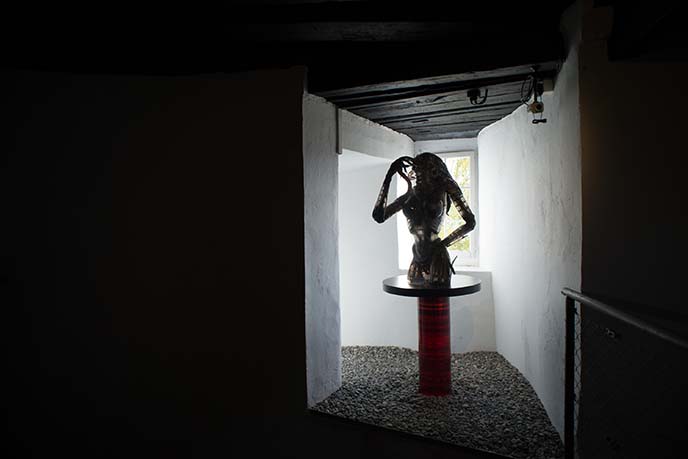
Giger had always worked with various media, but started focusing on sculptures in the mid-1990s. He’s even designed album covers and computer games over the years, always with haunting hybrids of human and machinery.
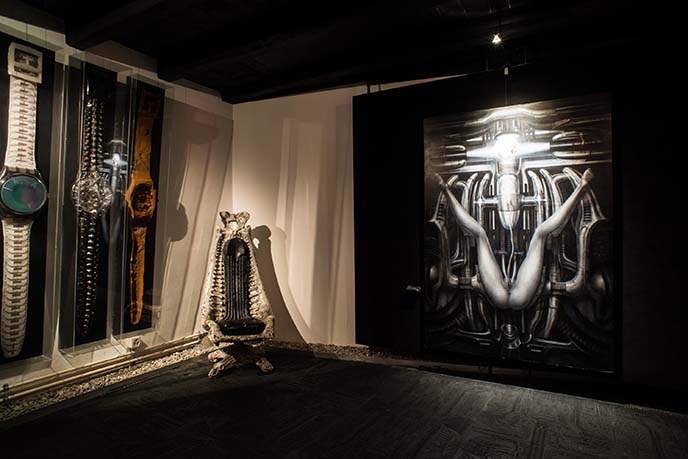
It was a treat to see Giger’s lesser-known works, including mirrors and light fixtures… and even giant wristwatches.
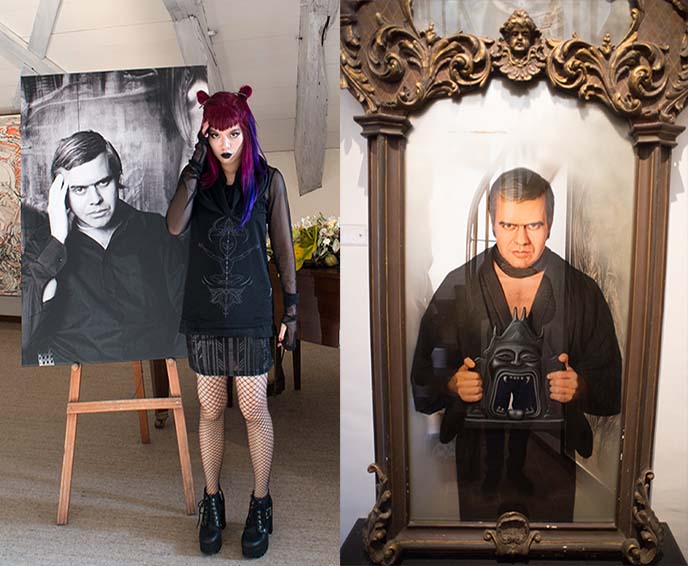
On the top level, there were these two portraits of the artist. HR Giger worked up to the end of his life in 2014, when he died from injuries after a fall on the stairs.
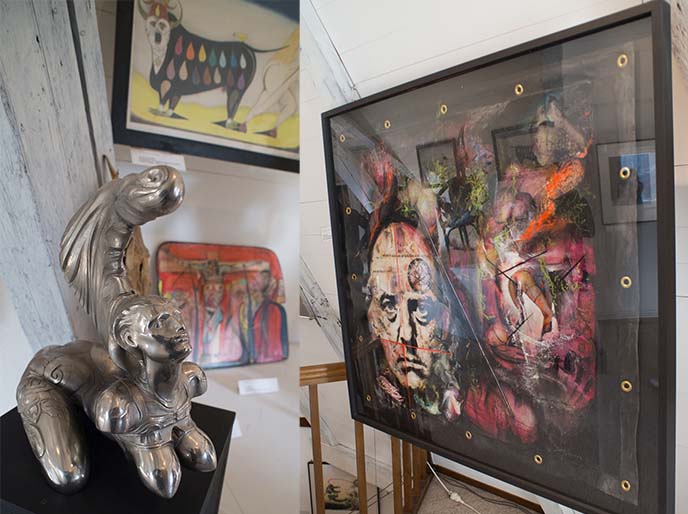
The top floor of the museum houses Giger’s personal art collection. There are works by Salvador Dali, mixed in with creepy totems picked up during his travels.
The H.R. Giger Museum Gallery also exhibits rotating works by contemporary artists, who share his love of fantasy and surrealism.
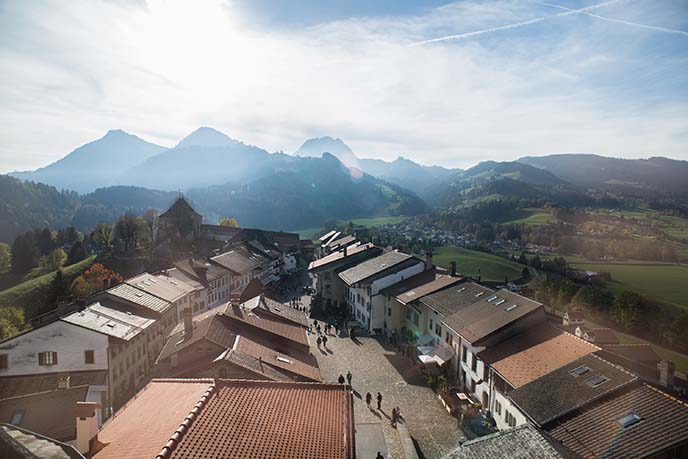
Don’t forget to look out the top floor window, for this gorgeous view of Gruyeres. No wonder Giger stayed in Switzerland and built his museum here, even though he could have lived anywhere.
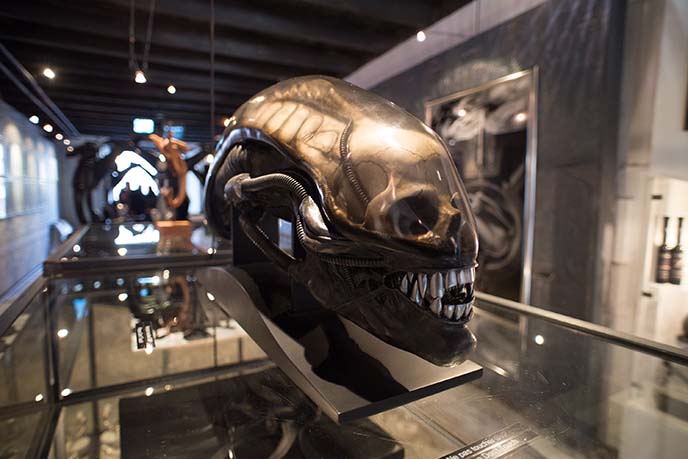
As you leave, check out the Giger gift shop. It sells books, prints, cups, absinthe… or how about a giant alien head?

Mind blown after stepping into the dystopian world of Giger. It’s amazing to have so many of his seminal works in one beautiful village.

In the words of Alien director Ridley Scott: “At its essence, Giger’s art digs down into our psyches and touches our very deepest primal instincts and fears. His art stands in a category of its own.”
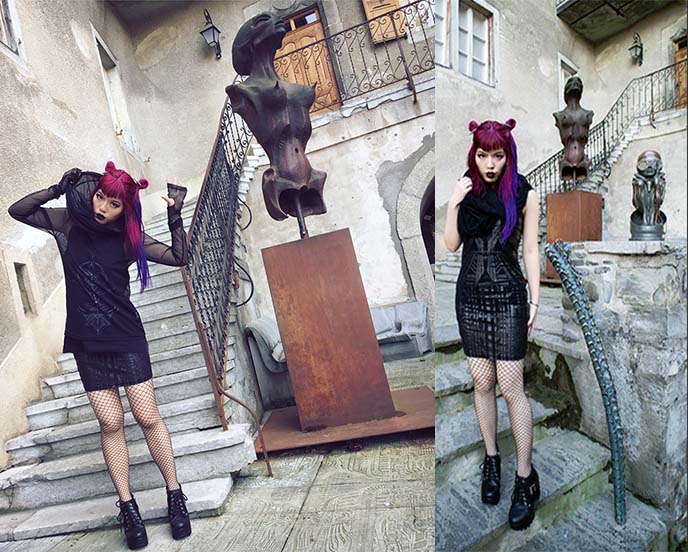
I hope you’ll have the chance to make the journey to Gruyeres, and take photos with his deadly star beasts!
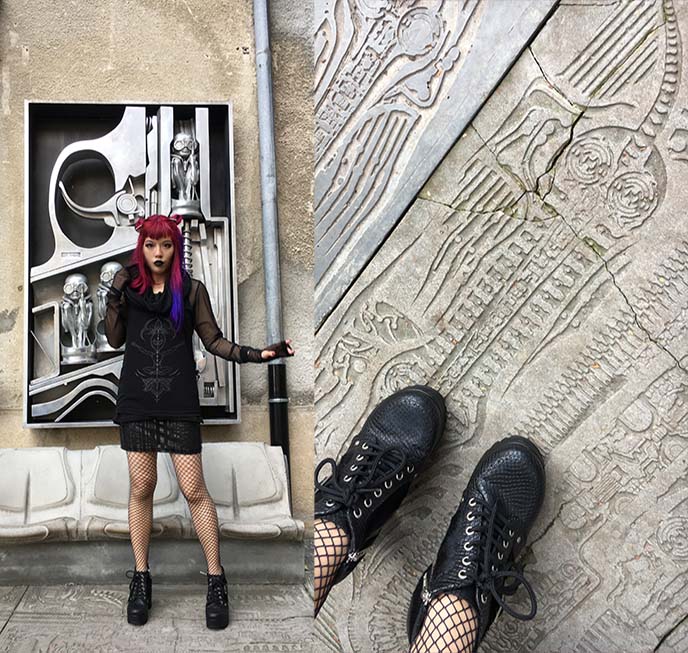
For visiting info, here’s the website for the H.R. Giger Bar. Don’t forget to allow a lot of time in Gruyeres, as there may be a lineup. You can always hang out outside, and take photos with the alien-sculpted floor!

And here is more info on the Museum HR Giger website, including opening hours, admission rates, tickets and more.
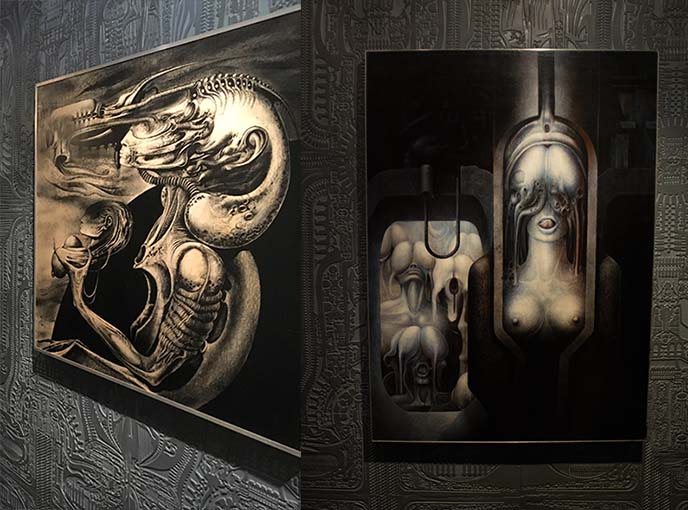
I leave you with a line by HP Lovecraft, from his horror story “Pickman’s Model,” as I feel it captures Giger’s power.
He’s an artist who “knows the actual anatomy of the terrible or the physiology of fear — the exact sort of lines and proportions that connect up with latent instincts or hereditary memories of fright, and the proper color contrasts and lighting effects to stir the dormant sense of strangeness.”

Are you also a fan of HR Giger’s oeuvre? Would you want to visit his Swiss bar and museum? Coming up, I’ll show you more from Gruyeres, including the chateau and cheese.
If you enjoyed this in-depth post, I hope you’ll take a minute to share it on Facebook and social media. I appreciate it, and am excited to bring more travel stories like this to you!


 LA CARMINA
LA CARMINA






